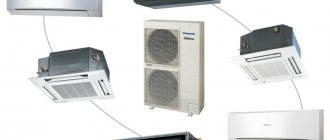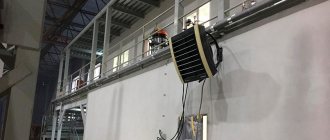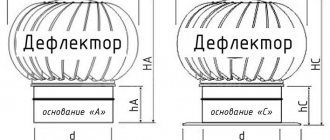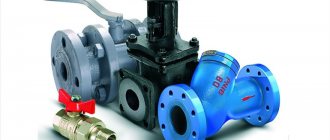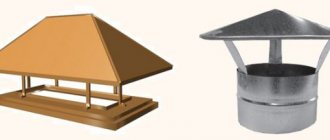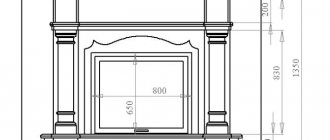In our time, you cannot imagine your life without ventilation systems. They are installed in industrial buildings, offices, educational institutions, shops, apartments. The operation of these systems is inconceivable without the use of exhaust fans of various capacities. A widespread element of apartment ventilation is a kitchen hood. It can have various shapes, sizes, designs.

The amount of purified air in the room will depend on the calculation of the fan power of the kitchen hood.
Exhaust ventilation in the kitchen
But external beauty is not the most important thing. The main task of this device is to rid the kitchen room of odors, burning, soot and grease that appear during cooking. Exhaust ventilation removes fumes from various heating devices. It prevents the appearance of dirty deposits on the ceiling and wall surfaces. This allows cosmetic repairs to be performed much less frequently, which will save you a significant amount of money. It will take less time to carry out general cleaning.
A device capable of passing a certain amount of air through its filters can cope with the task of cleaning the atmosphere in a room. And for this you need to choose a device with a fan of the required power. How to calculate the power of the device?
How to check if the ventilation is working
In old houses, the work of ventilation shafts is often disrupted: over time, they become clogged and cease to perform their functions. Therefore, first you need to check the condition of the ventilation duct. If it is clogged with something, the efficiency of not only natural, but also forced ventilation will decrease.
USEFUL INFORMATION: Classic bathroom design: examples and photos
To find out if the ventilation in the bathroom is in working order, simply:
- The windows and the door to the bathroom are slightly opened in the apartment.
- Take gauze, napkin or handkerchief and apply to the opening of the ventilation duct.
- If the air duct works properly, the fabric or paper will stick to the hole by itself. The tighter the handkerchief or napkin is pressed, the better the draft in the shaft. If they do not hold, they fall, then something is wrong with the channel, you need to find out the reason why the ventilation does not work.


Another test can be carried out, it is also very simple and indicative:
- also slightly open the vents and doors;
- light a candle and bring it to the exit of the mine;
- if the light leans towards the hole, then there is a thrust; if it burns without moving, then the air stands still.
Then the experiments should be repeated with the vents and doors closed. If in this case, too, the light deflects or the leaf sticks to the hole, then the traction is good, strong. In this case, it is unlikely that there will be a need to install forced ventilation. If there is no draft, then it will not hurt to install an additional fan.
The main reason for the lack of traction is the clogging of the channel. In this case, it is necessary to clean the mine, if necessary, contact the management company. It happens that residents of the upper floors brick up the ventilation, which also interferes with air circulation. This issue will also have to be resolved through the Criminal Code.
Fan power calculation
To calculate the fan power, you need to do the following:


An example of calculating the performance of a kitchen hood fan.
- Using a tape measure, measure the size of the kitchen and determine its volume in meters. To do this, the length must be multiplied by the width and height. The BTI documents indicate the area of the premises. Example: the kitchen area is 10 m². Height from floor to ceiling - 3 m.We multiply the area by the height and get 30 m³. This is the volume of the kitchen.
- Next, the value that characterizes the air exchange is calculated. To do this, you need to multiply the volume of the kitchen by the number of complete air updates per hour. Building codes and regulations (SNiP) provide for an air exchange rate of 10-12. Thus, to calculate the capacity of the exhaust system, you need to multiply 30 m³ by 12. As a result, the figure is 360 m³ / hour. That much air must be renewed every hour.
- To carry out exchange in such a volume, a fan with a capacity of 400-800 m³ / hour is needed. But standard ventilation ducts are capable of passing only about 180 m³. Therefore, the fan will not help much here.
- In this case, a recirculating exhaust system will help, which passes air through filters and sends it back to the room. Power is also required to overcome the resistance of the filters. Therefore, 40% should be added to the calculated figure. It turns out 560-1120 m³. This should be the capacity of a kitchen hood fan of 30 m³.
- In some cases, you can do without a ventilation duct. For this, the exhaust fan is installed in a specially equipped opening in the wall, in the ceiling or at the junction of the ceiling and wall. This mounting allows the use of a less powerful fan.


Exhaust power for different rooms.
This is just the simplest calculation of the required power of the exhaust fan. If the kitchen does not have doors, then the volume of the adjacent room must also be taken into account. So, the formula for calculating the fan power for general cases: room width x length x height x exchange rate = desired value. You can calculate the volume of the room without any problems. It is enough to measure the length, width and height and multiply them.
How to find out the fan performance


Modern fan
When purchasing a ventilation device, everyone wants to know and check its performance. The performance of the described device refers to the volume of air pumped over a certain unit of time. Therefore, everyone wants to buy a device with higher performance! It is measured in "CFM", which means cubic feet per minute or m³ (cubic meters) per hour.
An equally important characteristic of this device is its power, which is measured in "kW" and "kW". In this case, the variable value is the rotational speed, measured in the number of revolutions produced per minute of time.
The calculation of the fan, or rather its performance, is also associated with:
- the diameter of the blades;
- noise level;
- full pressure.
The performance of the fan is indicated on the packaging of the device or is prescribed in the instructions attached to it. Normally, such a device refreshes the air in the room every 4 minutes. At the same time, an important indicator is the volume of the available premises. The larger it is, the greater the load on the described device. By the way, you can calculate the volume of a room where you need to "renew the air" using a simple school formula: multiplying the height by the width and length!
The required shift rate recommended by SNiP is a range from 10 to 12 times per hour. By multiplying the available volume of the room by any value from this range, you can get the required performance in a single room. By summing the resulting value with the calculations of the areas for all rooms of the house, you can find out the required performance for the entire living area.
In practice, the norms required by calculations are rarely implemented, therefore, in real conditions, everything is somewhat different, as for good air flow. So, for the minimum established rate of air exchange in the room, it is enough to open a window or rely on the draft created in the ventilation duct.


Exhaust fan for kitchen
Bathrooms and kitchens require more efficient fans, or they must run longer than in other rooms, as showering and cooking alters the composition of the air, saturating it with water vapor and carbon monoxide. For such rooms, the activity of the device in a "reinforced exhaust", which must be installed on the device, is suitable.
An important role is played by the installation of an axial fan, which is a blade blowing machine that transfers mechanical energy in the form of kinetic and potential energy from the rotation of the blades located on the impeller. The calculation of the air exchange of axial fans is carried out taking into account the efficiency (efficiency), the aerodynamic characteristics of the device and the performance of the unit. This value can also be indicated in the instructions supplied with the device.
Air change rate
The multiplicity for rooms of different types is determined as follows:
| Room type | Multiplicity |
| Bakery | 20-30 |
| Greenhouse | 25-50 |
| Office | 6-8 |
| Bathroom, shower | 3-8 |
| Barbershop | 10-15 |
| Restaurant, bar | 6-10 |
| Bedroom | 2-4 |
| Lobby | 3-5 |
| Classroom at school | 2-3 |
| Cafeteria | 10-12 |
| Hospital chamber | 4-6 |
| Score | 8-10 |
| Basement | 8-12 |
| Kitchen in a house or apartment | 10-15 |
| Gym | 6-8 |
| Attic space | 3-10 |
| Catering kitchen | 15-20 |
| Pantry | 3-6 |
| Changing room with shower | 15-20 |
| Laundry | 10-15 |
| Toilet in the house, in the apartment | 3-10 |
| Conference hall | 8-12 |
| Living room | 3-6 |
| Billiard room | 6-8 |
| Public toilet | 10-15 |
| Garage | 6-8 |
| Meeting room | 4-8 |
| Utility room | 15-20 |
| Library | 3-4 |
| Dining room | 8-12 |


Table for calculating the minimum performance of the hood relative to the volume of the kitchen.
The highest frequency ratio is chosen for use in rooms with many people, with high humidity and temperature, with a lot of dust and strong odors. In a kitchen with an electric hob, you can choose a lower value, with a gas stove - a larger one. This is due to the fact that the gas, when the stove is on, releases combustion products. The fan, selected taking into account the above data, can be mounted in the wall, window, ceiling of the room.
Room analysis and problem statement for the system
Check with a sheet of paper or a candle whether the exhaust ventilation duct of the apartment, the outlets of which are located in the bathroom and in the kitchen, is working.
To determine the number and performance of air inlets required in a particular room, you can use two options, which are relevant depending on the complexity of the entire system.
Option number 1. Professional engineering online calculator. This method is filled with rather complex terms and formulations and is more suitable for complex layouts with many rooms that have different requirements for air exchange. Full use will require knowledge and professional experience.
Option number 2. Self-calculation, suitable for the requirements of SNiP. Ventilation of an ordinary apartment or a small house has minimal complexity, so any home craftsman can handle it.
For the independent implementation of the project, five indicators are required.
Duct diameter. A complex calculation based on SNiP data, the number of people, the functions of the room at different times of the day, etc. However, it is known from experience that it all comes down to three popular diameters (sections) of the channel - 100, 125 and 150 mm. Respectively:
- 100 mm - for constant continuous air exchange around the clock at low fan power;
- 125 mm - periodic ventilation while people are in the room (for example, from 18.00 to 8.00) at low and medium power;
- 150 mm - quick ventilation 1-2 times a day for rooms with an irregular or rare presence of people.
Accordingly, the diameter of the duct in our case does not depend on the power of the devices, but on the requirements for the room.
Fan performance. Measured in m3 / hour.According to SNiP 41-01-2003 "Heating, Ventilation and Air Conditioning", the air exchange must be at least 3 m3 per hour per 1 m2 of living space. In other words, the system must pass the entire volume of air in the room through itself in 1 hour. Please note that supply ventilation provides an air flow of 5 to 40 m3 / h, depending on the set mode.
The shape, section and walls of the channel. There are obstacles that can significantly affect system throughput:
- The corrugated walls of the duct take 7-9% of the fan power. Choose smooth, round pipes.
- Right angles (90 °) of the duct - each corner takes 2-3% of the fan power. Design the channel with as few corners as possible.
- Filters and noise absorbers. Their throughput and losses are also indicated in the factory documents.
The performance of the supply air devices. It must be equal to the capacity of the exhaust system, otherwise the exhaust fans will operate under load and without proper results. The figures for this main indicator are always in the instructions for the supply devices.
The specifics of the premises. You can complicate the task by applying the calculation of air per person or by the frequency of exchange, but in practice, there is enough information from the SNiP norm - 3 m3 per 1 m2 for bedrooms, living rooms, children's rooms. The same document talks about fixed rates:
- For the kitchen - 90 m3 / hour.
- For the bathroom - 25 m3 / hour.
- For a toilet - 30 m3 / hour.
- For a combined bathroom - 35 m3 / hour.
It should be noted that these standards have been developed with a huge margin, which is not implemented in practice. The problem of humidity and foreign odors is solved if necessary - during cooking or shower, a reinforced hood is turned on. To ensure fixed rates with good draft in a standard ventilation duct, it is enough to provide an inflow. When installing the fan on a standard duct, the inflow must also be increased.
